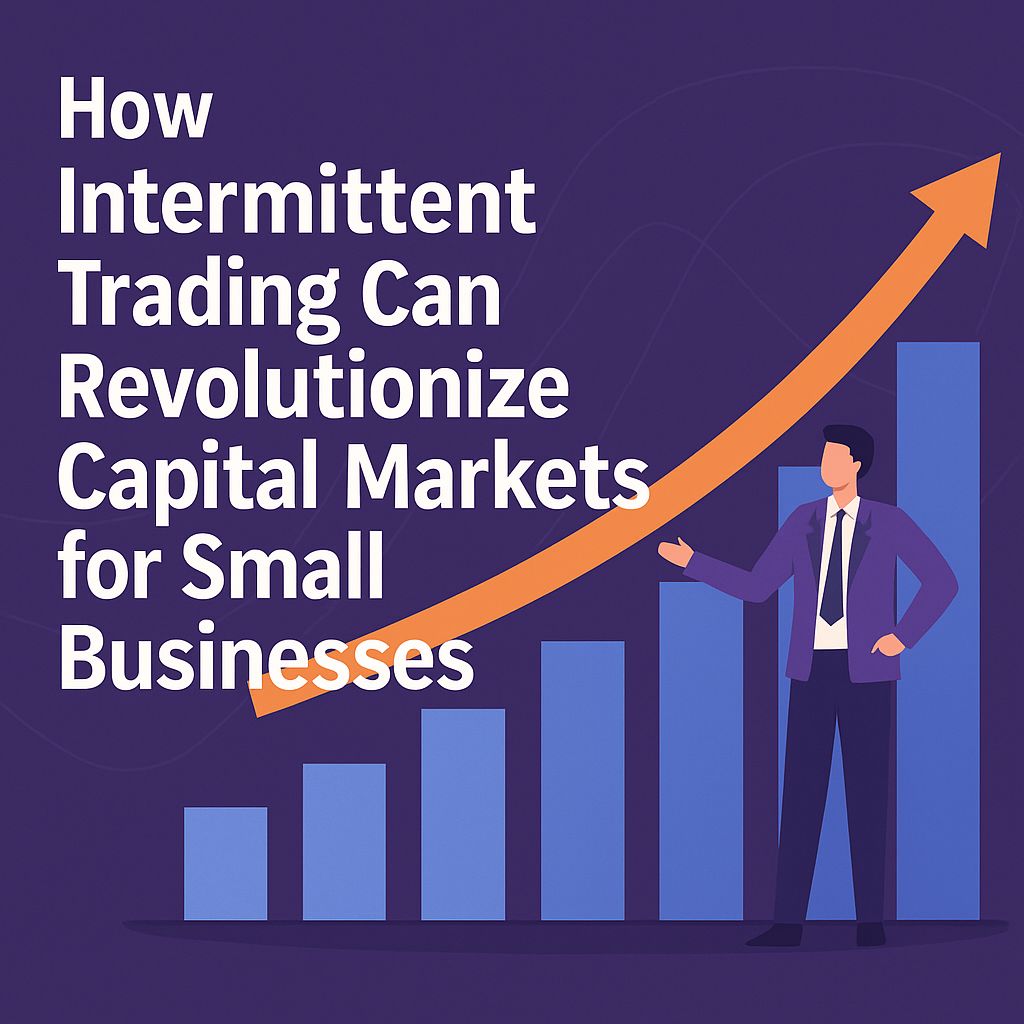- The Exponential Blueprint
- Posts
- The $13 Trillion Market That’s Ignoring You (For Now)
The $13 Trillion Market That’s Ignoring You (For Now)
How intermittent trading, equity strategies, and the Magic Triangle can put your business on the capital map.
Learn from this investor’s $100m mistake
In 2010, a Grammy-winning artist passed on investing $200K in an emerging real estate disruptor. That stake could be worth $100+ million today.
One year later, another real estate disruptor, Zillow, went public. This time, everyday investors had regrets, missing pre-IPO gains.
Now, a new real estate innovator, Pacaso – founded by a former Zillow exec – is disrupting a $1.3T market. And unlike the others, you can invest in Pacaso as a private company.
Pacaso’s co-ownership model has generated $1B+ in luxury home sales and service fees, earned $110M+ in gross profits to date, and received backing from the same VCs behind Uber, Venmo, and eBay. They even reserved the Nasdaq ticker PCSO.
Paid advertisement for Pacaso’s Regulation A offering. Read the offering circular at invest.pacaso.com. Reserving a ticker symbol is not a guarantee that the company will go public. Listing on the NASDAQ is subject to approvals.

The $13 Trillion Market You’re Locked Out Of
Why Most Founders Never Get Funded — And How to Change That with One Triangle
Preview text: Discover how PISCES and the Exponential Blueprint help small founders go from invisible to investable in today’s private capital markets.
The $13 Trillion Reality
Private capital markets are at an all-time high, reshaping the landscape of global finance.
With total assets under management soaring to $13 trillion and projections of $20 trillion by 2030, these markets host more than 215,000 private equity- and venture capital-backed companies — a staggering 25 times the number of publicly listed firms.
Yet, despite this immense pool of capital, many small and medium-sized businesses find themselves on the outside looking in. In 2023 alone, fundraising dipped to $1.0 trillion, the lowest since 2017, with venture capital deal counts seeing the sharpest decline.
Despite this, private debt emerged as a top performer in 2024, with returns of 9.11%, outpacing even some of the most prominent public market indices.
But for many founders, these numbers might feel distant, even frustrating.
You may be asking, "If there's so much capital out there, why can't my business tap into it?"
The Capital Markets Lockout: The Invisible Founder
If you’re a founder of a scaling or stagnating business, the feeling of invisibility in the eyes of investors and capital providers is all too familiar.
You’re not alone. Thousands of small and medium-sized enterprises (SMEs) share this struggle.
Despite having innovative products, loyal customer bases, and strong growth potential, these businesses remain unseen by mainstream capital markets.
The reason? It’s not a lack of value but a lack of visibility.
Traditional pathways to capital, like public listings or large-scale private equity deals, often come with high barriers — complexity, cost, and the need for a certain scale that many SMEs haven’t yet reached.
Without a clear exit plan or a visible share price, even the most promising businesses can be overlooked.

PISCES: A New Dawn for SMEs
Imagine a capital market designed specifically for businesses like yours.
That’s where PISCES (Private Intermittent Securities and Capital Exchange System) comes in. PISCES offers a revolutionary approach that allows SMEs to participate in intermittent trading, enabling founders to sell a portion of their shares a few times a year without the need for a full-scale IPO.
This not only provides liquidity for founders but also establishes a real-time valuation that can transform relationships with banks, investors, and even employees.
It’s a simpler, more cost-effective solution compared to traditional public listings, making it a perfect fit for businesses that have long been overlooked.
With PISCES, visibility becomes your superpower:
✅ Sell a portion of your shares without giving up control
✅ Establish your valuation without going public
✅ Motivate your team with real equity potential
✅ Improve bank relationships by showing a transparent market value
✅ Attract investors who want to enter — and exit — on founder-friendly terms
Below is a podcast released with Sam Palazzolo, US-based investment banker. Join over 16,000 YouTubers who have watched it.
PiSCES vs. Public Markets: A Structured Comparison
Feature | PiSCES (Intermittent Trading) | Public Markets (Continuous Trading) |
|---|---|---|
Trading Frequency | Intermittent trading at flexible intervals. | Continuous trading during market hours, with ongoing obligation to provide liquidity. |
Cost | Simpler and more economical. | Higher upfront and ongoing costs due to complex regulatory compliance. |
Share Availability | Shares are available during specific trading windows only. | Shares are available for trading at any time during market hours. |
Disclosure Requirements | Less stringent. Annual or periodic reports based on trading activity and valuation events. | Extensive quarterly disclosures and real-time market updates required. |
Visibility | Company valuation becomes visible at each intermittent trading event. | Full real-time valuation and price visibility at all times. |
Regulation | Light-touch regulation. | Highly regulated environment designed for large-scale public corporations. |
Access | Limited to selected investors or stakeholders via private placement. | Open to the general public and institutional investors alike. |
Employee Motivation | Employees can benefit from equity through periodic liquidity events (e.g. via share sales). | Stock options or grants with continuous market pricing, allowing consistent visibility of value. |
Real Stories: From Factory Floors to Fortune
You’ve heard of NVIDIA. But let’s look closer:
Over 6,000 employees became millionaires at NVIDIA — not because of salary, but because they held shares in a company that executed a strong exit and valuation strategy.
Their equity plan changed lives, fueled loyalty, and created unstoppable momentum.
But here’s the secret:
You don’t need to be a tech giant to make this happen.
In Yorkshire, a 38-person manufacturing company implemented an employee share scheme.
Five years later, they exited for £42 million.
The founder retained control. The team shared in the success.
A local business. A life-changing outcome.
This is the power of visibility. Of structured equity. Of thinking ahead.
Below is a YouTube anticipation of our podcast with James Hunt on Private Trading for Small Businesses
The Exponential Blueprint Triangle
Since 2017, the Magic Triangle has helped founders turn stagnation into scale:
IP Monetization – Define and price what makes your business unique
Leadership Shift – Stop doing everything; build your 3-person winning team
Market Expansion – Learn to scale your business like a $100M operation
It’s not theory. It’s a system.
And now, it’s available in a digital format with 20 transformative videos that walk you through valuation, structure, and visibility step by step.
This is the Blueprint behind the stories you see in the headlines — and it’s finally accessible to you.
If you’re a founder who:
Feels stuck between startup hustle and real scale
Wants to exit someday, but doesn’t know how
Knows your business has value, but can’t prove it to banks or investors
Then you’re the person we built this for.
🟣 Explore the Magic Triangle Program — now in digital format
🟣 Get in touch for direct PISCES insights and founder-first guidance
🟣 Join the movement of SMEs reclaiming their place in the capital markets
Your value shouldn’t be invisible.
It’s time to structure it, show it, and scale it.
20 videos. Real strategies. Zero hype.
M&A : The Expert Corner, From Indonesia
When integration falters, many factors can contribute, but two stand out as particularly critical and can be prevented with proper planning:
Inadequate Due Diligence
The primary culprit is often a due diligence process that lacks the necessary depth.
Whether due to unavailable data, a lack of confidence in the findings, or other underlying issues, the outcome is consistently detrimental.
Key risks remain hidden, preventing proper mitigation and accurate financial accounting. This directly impacts the business case, leading to an incomplete understanding of the true cost structure for the integration and even missed opportunities for value creation.
Unrealistic Business Case Assumptions
The second major reason for integration failure stems from unrealistic assumptions within the initial business case.
These flawed assumptions, whether concerning aggressive growth ratesor the useful ligfe of assets, create immediate and significant gaps between projections and reality. This sets the integrationup for challenges right from the start.
Contact us to ensure your next integration is a resounding success!
Marguerite Bolze
Below is our podcast with Marguerite Bolze, M&A expert. Marguerite has conducted 14 M&A operations in her career.
What’s Coming in Future Editions
We’re not done. The next few editions of The Exponential Blueprint will dive deep into:
How PISCES intermittent trading really works
How to structure your first share sale without an IPO
How founders like you are securing liquidity and maintaining control
How to craft equity strategies that attract investors and empower teams
Thanks to new partnerships with PISCES operators, you’ll get privileged access only available here.
See you in the next edition — where your valuation finally becomes visible.
How did you like today’s Newsletter? |
Matteo Turi
Founder, Exponential Blueprint
CFO | Entrepreneur | Valuation Strategist


Reply